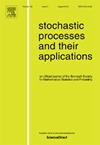Convergence of adapted smoothed empirical measures
IF 1.2
2区 数学
Q3 STATISTICS & PROBABILITY
引用次数: 0
Abstract
The adapted Wasserstein distance (-distance) controls the calibration errors of optimal values in various stochastic optimization problems, pricing and hedging problems, optimal stopping problems, etc. However, statistical aspects of the -distance are bottlenecked by the failure of empirical measures (Emp) to converge under this distance. Kernel smoothing and adapted projection have been introduced to construct converging substitutes of empirical measures, known respectively as smoothed empirical measures (-Emp) and adapted empirical measures (-Emp). However, both approaches have limitations. Specifically, -Emp lack comprehensive convergence results, whereas -Emp in practical applications lead to fewer distinct samples compared to standard empirical measures.
In this work, we address both of the aforementioned issues. First, we develop comprehensive convergence results of -Emp. We then introduce a smoothed version for -Emp, which provide as many distinct samples as desired. We refer them as -Emp and establish their convergence in mean, deviation and almost sure convergence. The convergence estimation incorporates two results: the empirical analysis of the smoothed adapted Wasserstein distance (-distance) and its bandwidth effects. Both results are novel and their proof techniques could be of independent interest.
自适应平滑经验测度的收敛性
自适应Wasserstein距离(AW-distance)控制了各种随机优化问题、定价与套期保值问题、最优停止问题等最优值的校准误差。然而,由于经验测度(Emp)不能在此距离下收敛,使得aw距离的统计方面受到瓶颈。引入核平滑和自适应投影来构造经验测度的收敛替代品,分别称为平滑经验测度(S-Emp)和自适应经验测度(A-Emp)。然而,这两种方法都有局限性。具体而言,S-Emp缺乏全面的收敛结果,而A-Emp在实际应用中与标准经验测量相比,不同的样本较少。在这项工作中,我们解决了上述两个问题。首先,我们得到了S-Emp的综合收敛结果。然后,我们介绍了a - emp的平滑版本,它提供了尽可能多的不同样本。我们将其称为as - emp,并建立了它们在均值、偏差和几乎肯定收敛方面的收敛性。收敛性估计包含两个结果:平滑自适应Wasserstein距离(AW(σ)-距离)及其带宽效应的实证分析。这两个结果都是新颖的,它们的证明技术可能具有独立的兴趣。
本文章由计算机程序翻译,如有差异,请以英文原文为准。
求助全文
约1分钟内获得全文
求助全文
来源期刊

Stochastic Processes and their Applications
数学-统计学与概率论
CiteScore
2.90
自引率
7.10%
发文量
180
审稿时长
23.6 weeks
期刊介绍:
Stochastic Processes and their Applications publishes papers on the theory and applications of stochastic processes. It is concerned with concepts and techniques, and is oriented towards a broad spectrum of mathematical, scientific and engineering interests.
Characterization, structural properties, inference and control of stochastic processes are covered. The journal is exacting and scholarly in its standards. Every effort is made to promote innovation, vitality, and communication between disciplines. All papers are refereed.
 求助内容:
求助内容: 应助结果提醒方式:
应助结果提醒方式:


